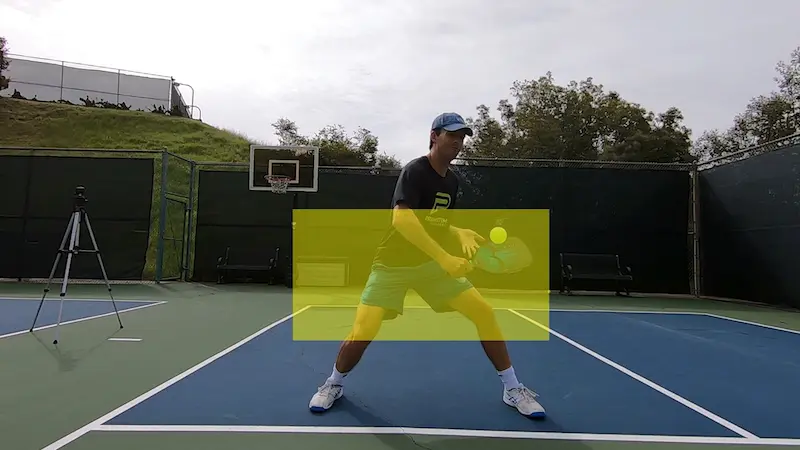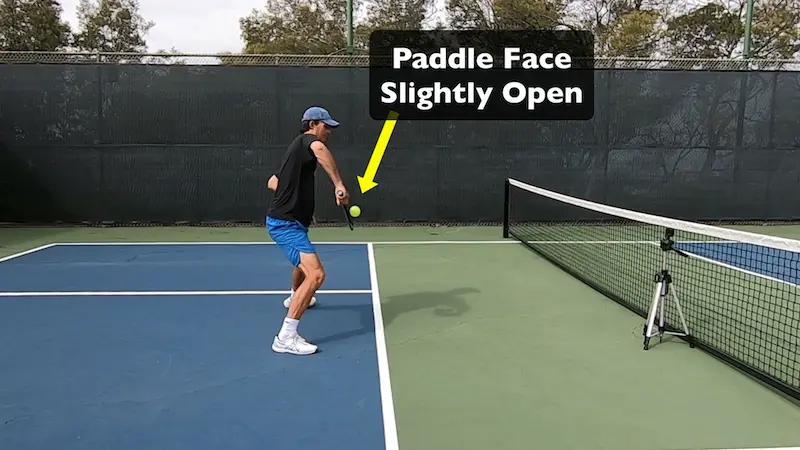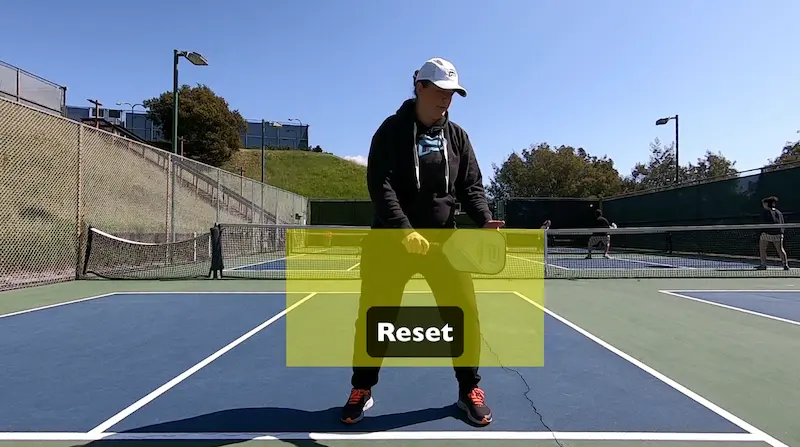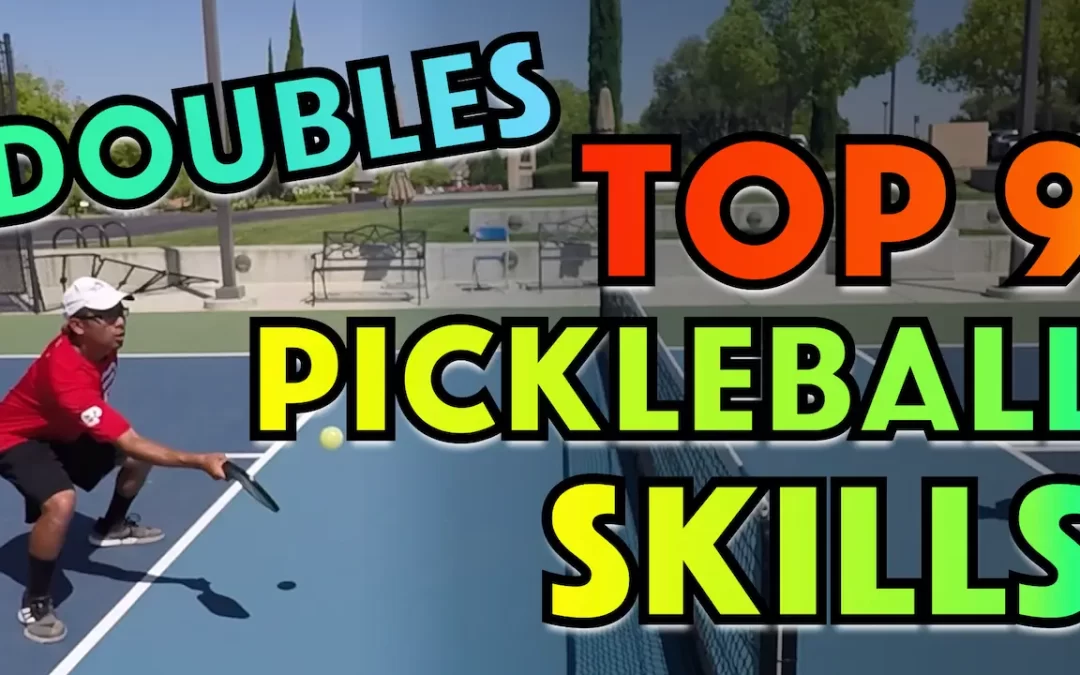We’re going to talk about the five main reasons why you pop it up with balls that are hit hard towards your body and what you should do instead to keep it low and prevent repetitive attacks.
We’re going to be talking about when you get attacked at the non-volley zone line and primarily on balls that are coming in the range of approximately the waist area and below. (image displayed further down)
These types of balls have been hit low crossing the net, and hard.
You’re going to want to block those because that’s the best defensive play.
If they’re high, you can counterattack but that’s the subject of a different video/blog.
We’re going to talk about getting attacked in the range I mentioned above because that’s typically where the attacks are coming.
If they’re coming hard and high, unless they have a tremendous amount of topspin, they’re going out. We’re not going to worry about those as much right now.
I see a lot of people having trouble with this block here that comes in this area (see below) which is much more common and easier to defend.

We want to clean that up first before we worry about anything else, and we want to be strong blocking from this area so that we can get out of trouble and mount our attack back on them.
Blocking in this lower area is easier than a higher block (approximately wait level and above) is because with a higher block it’s easier to get jammed up near your hitting shoulder.
You’ll see a lot of people wanting to attack the hitting arm shoulder which is a smart play. We’re not covering that today.
We’re just covering the lower area I mentioned because it’s extremely common and I see a lot of people messing this up. It is easier because it can be defended well comfortably with forehands and backhands.
When I say block, you’re doing a reset. A reset is when the incoming ball has a lot of pace and you’re taking all that pace off and dropping it in or near the kitchen to force them into a low contact because your ball is soft and it’s going to bounce low and stay short in the court.
That’s how you’re going to reset the point so that you don’t continually get attacked. A blocking reset shot.
We’ll go over the 5 reasons why you may pop up these reset shots now.
Reason #1 – Trying To Block With Your Forehand
The first main problem that I see on these blocks here in this area is that players are trying to block that shot when it comes into their body with their forehand.
This is much more difficult than a backhand block.
I’ll often see them even coming up to the net, they’re late on the split, they get attacked in the body and then they’re doing a forehand pop up block and it just goes badly.
No matter where you are in the area at or approaching the non-volley zone, you’re going to be wanting to block your body with your backhand.
Anything from here is a backhand. (see image below)

A lot of people think that it’s an even distribution between the forehand and the backhand. (see image below)

That’s not true at all.
You want to be blocking from your right hip and over with your forehand and the remaining area with your backhand. (see image for backhand zone above (blue rectangle) & see image for forehand zone below)

The area shown below is a bit of a decision zone. If you want to do a backhand or a forehand that’s okay.

Keep that in mind. It is not an even distribution.
I see players blocking with their forehand when they should be using their backhand because people are more comfortable often on the forehand side.
That’s going to limit you from progressing.
Reason #2 – Too Jerky With Body Movement During The Block
I understand your opponents are coming with power and your reflex is to resist it. But, you must train yourself to stay calm and relaxed and not to be making jerky movements as the ball comes at your body.
You don’t want to use too much body.
You’re going to stay calm. Keep your body as stable as you can while you block.
Use very smooth, soft, and efficient motions.
They must be quick, but they must be minimal.
You don’t want to be retreating. Even if you aren’t retreating you don’t want to have too much going on with your body because you’re blocking, and an attack can be coming again so you don’t want to be out of position with your body enough not to be able to recover as there’s not a lot of time.
It’s going to help your shot and your subsequent shot if you keep your body movement to a minimum and then just block with your hand and your arm as much as possible.
You’ll see that when you’re watching the pros, they’re not jerky. They’re as still as they can be. They must be fast, yet still.
Reason #3 – Don’t Have Too Much Tension In Your Body
When you’re being as still as you can be yet fast you also have to have softness throughout your body.
If you’re tense, you’ll be more likely to be jerky.
Also, when you’re tense, and even if you’re not jerky, the ball is going to rocket back off your paddle and you’re not wanting to do that.
You’re wanting to block it and reset it in the kitchen.
To do that you have to take some pace off the ball.
You can’t take pace off the ball if you’re tense. They’ll maybe get another high one and you’ll pop it up.
If you’re tense, you’re much more likely to pop it.
You want to be soft, get that paddle face angle right, block, and just let it bounce off your paddle. You want to do this especially if it has a lot of paces on it and you must absorb the shot a bit with your hand and your body.
You’ll see a lot of people be very still and as the ball comes, they just relax, let the paddle and the body absorb the shot, and drop it in the kitchen.
It is an advanced skill, but it is highly trainable.
You must have limited tension in your body.
Reason #4 – Paddle Face Should Not Be Too Open
If it’s open that’s going to send the ball high. If it’s too open and too tense, it’s going to send the ball even more high.
You could do a lot of things right but if your paddle face is a little too open that’s going to pop it up.
You’re going to have it a lot more level than you think.
It may be slightly open but it’s not going to be very open. Then with your soft body, your limited flinching, and your correct paddle face motion, you’re just going to let that ball bounce off the paddle and it’s going to drop into the kitchen.

So, if you’re finding that it’s going too high, but you feel everything else is right, make sure that paddle face is not too open.
That’s one of the main reasons players pop it up. They’re not closed enough.
We’re not going to have it closed completely. It will only be slightly open.
Reason #5 – Don’t Counterattack When You Should Reset
Typically, when the ball’s coming approximately waist high or lower (see image below), you’re going to want to reset.

When it’s approximately waist level or above (see image below), you can maybe counterattack depending on where they are. If you feel you can get it down on them great.

Description of scenario in video at top of post – Ryan hits a cross-court dink that seems to go a little higher than he intended. Alex decides to attack straight ahead to Michelle who feels she has a high enough contact to counterattack, so she does. Kady hits a reset block that goes a bit higher than she intended. Michelle follows up with an attack that ends the point.
Often, I’m seeing counterattacks from areas that are too low (below waist level). Unless you can do topspin that’s not a good idea.
You want to be really picky about when you’re counterattacking.
With the grit on paddles getting more and more and with topspin coming into the game more and more, certainly you can counterattack more. However, I’m often seeing flat counterattacks, no top spin and you’re just giving them high contacts.
If they don’t mind the pace, they’re going to have high contacts to punish you repeatedly with.
You want to learn how to reset these balls. It is a key skill if you want to move up in levels. There’s no way around that.
If you seem to be popping it up a lot with resets from the area approximately waist level and below, then check these things and fix them and your resets will be so much better when blocking shots in this mid to low range.






